Museums persuasively communicate with their audiences through display techniques, and visitors experience the museum through curatorial negotiation. Prosthetics like label text, docent monologues, and exhibition catalogues have long mediated the relationship between viewers and objects. In recent years, however, in the context of late capitalism's facility for mass customization and media saturation, encounters with objects both in and out of the museum have been obscured by stylistic details that relate them more to a larger culture of design than those developed organically from objects themselves. In turn, experiences within the museum cannot help but be affected.
One way curators attempt to respond to the cultural appetite for consuming highly designed experiences is by incorporating technology into exhibition display techniques. Technology-facilitated museums immerse visitors in simulated three-dimensional hyperreal environments, and interpretive technologies such as mobile digital guides and interactive kiosks engage visitors by providing ancillary object information in the form of enhanced video, audio, games, and select customizable features. While technology-facilitated experiences—both real and virtual—create a tenuous relationship with museum objects, these applications can also forge new paths and datascapes. As museum technologies continue to push the boundaries of interactivity, participation, and visualization, museums are challenged to create networks which encourage information exchange while maintaining the aura of the museum object, and the museum itself.
__________________________
Through the dials of your Teleset you will share in the ownership of the world's great art treasures.- Frederick Kiesler
CREATING THE MUSEUM OBJECT Museums have a long history of choreographing visitor relations with objects, which begin well before either visitor or even object is actually inside the museum, and which are generally defined in contrast with routine use of objects. Objects acquire cultural significance by removing them from the everyday and embedding them with narrative.[1] When museums recontextualize objects, they not only not only sanctify those objects in cultural terms but also help generate a cult of authenticity, wherein curated objects attain a higher or deeper sort of existence than objects of everyday use. The managed encounters within museums create the authentic object.
Curatorial intervention produces the museum object by closing the circuit of language and visuality. The narrative of labels and informational guides provides a language marker that delineates and describes the object. These curatorial prosthetics first attract attention through written or verbal communication—label text might describe a particular feature of an artifact, an audio guide might expound on an artist's color palette—then turn attention back to specific aspects of the object. The viewer measures these qualities with their own eyes, thus visually confirming the validity of the curatorial guide. This interaction substantiates the value of the object, and the value of museum's interpretation. On the surface curatorial prosthetics direct attention to the museum object; below the surface, they construct the value of the object.
AUTHENTICITY AND AURA Museum visitors respond to what they believe is real. Indeed in the contemporary museum, the most frequently asked question regardless of the questioner's age, social status, and economic strata is if an object is "real."[2] While realness can refer to a myriad of characteristics (an object's originality, materiality, quality of craftsmanship, aesthetics, the pedigree of its maker), in museums an object is real—that is, validated as authentic simply by being in the museum.[3] The sanctified space of the museum with its highly refined display anchors objects' authenticity and infuses them with the aura of the museum's cultural authority. The symbolic realness created in the museum actually exceeds the object, transforming it from a work of art or artifact into an icon of that work.
The state of being authentic (real) relates to the value society places on objects in particular contexts. While venerated relics of the Middle Ages constituted value through religious context, the genesis of the modern formulation of the authentic (marked by the "aura" that surrounds the object) occurred as a consequence of industrial advances and changing labor practices in the late 18th century. Mechanized processes which multiplied object copies alienated the artisan from the cycle of production thus creating a distinction between original objects and mass-produced commodities.[4] In particular, the industrialized reproducibility of art caused a shift in the hierarchy of objects, where value was sorted according to the object's aura—the intangible but distinct metaphysical glow that provides an object's energy or draw. Industrialized processes made the original object more important, and museums made the distinction visible through display. Display mechanisms create a physical impediment that contrasts with the immediacy of everyday objects. This heightens the visceral response to the museum object aura—but for the piece of glass (of the vitrine) the viewer could touch the same canvas that Da Vinci touched, handle a rock from the moon's surface, or feel a bone from a prehistoric mammal. As a result, modern viewers have become conditioned to read object value through the circuit of display which generates aura. That is to say, museums maintain the secular cult of authentic objects through curatorial prosthetics which direct attention for visual verification by the viewer, while maintaining a reverential distance between object and the museum visitor.
HISTORICAL CONDITIONING Museums have been generating aura for hundreds of years by making objects authentic through display. Several specific historical precedents also reinforce this power of display. The world's fairs—particularly the 1851 Crystal Palace and the Columbian Exposition of 1893—publicly displayed art, products, and people in such a stylized way that they became emblems of moments or ideologies, rather than merely objects. Next, the spectacularization of early art and artifact collections—initiated first with cabinets of curiosities and further developed in the early museum entertainment model popularized by entrepreneur PT Barnum—synthesized the often uneasy relationship of aesthetics, education, and entertainment in a single environment by joining them in display montages.[5] The rising interest in visual imaginaries like the diorama and panorama also helped inaugurate an appreciation for optical simulations of art and events, further interweaving the object and its representation. Installation technologies immersed viewers in artificial but believable environments, evoking physical and emotional responses without the presence of material objects. Each of these displays conditioned the public to a particular way of perceiving what they viewed.
Display invention also privileged voyeuristic appraisal. Urban planners, store owners, and museum designers responded to the increasing scopophilia of the modern viewer by arranging objects based on their display value. Architectural promenade helped narrativize objects by configuring them within a temporal progression. This was registered in the museum in particular—while cabinets of curiosities were organized according to spatial placement, later museums configured objects in sequences of events through space. Objects were infused with aura and became authentic through their ability to symbolize certain moments on an historical trajectory. While the curatorial filter that permitted aesthetic contemplation had a subtractive effect—it removed the noise of the everyday by framing an object—the increasing use of design strategies both culturally and in the museum revised the focus from singular moments to a continuum of experience. The resulting additive character of display design generated aura not only around the authentic object, but around the museum itself.
TECHNOLOGY AND THE MUSEUM
The museum's cultural authority
derives from its recursive quality—the political and social function of
the museum creates its cultural importance, and its cultural status drives its
ability to function socially and politically. To
maintain this authority, museums actively register shifts in cultural and
aesthetic sensibilities and reflect them in changing practices of
representation and display. In the age of media-literate
audiences, museums are positioned on a trajectory toward full technological
integration, where museum-meaning is facilitated through technologies of
display.[6]
However the techno-utopian vision cannot be realized without seriously
considering the particular social changes that accompany new media.[7]
To address these factors, the proposed concept for the technocratic museum uses
a simple design methodology to predict user behavior in a non-tectonic museum,
and seeks to set-up a model around which technological development in the
next-generation museum could be shaped. The
next section outlines this concept, which contrasts the traditional museum
formulation of the closed circuit of the curated work of art, and proposes an
open system that reflects the logic and social morphology of contemporary
society.[8]
PREDICTING BEHAVIOR This methodology was designed to render typical museum visitor behavior as actionable data for designing a virtual museum system. While the method is anecdotal and episodic—it is based on observation, not on scientifically measurable data—it does provide a sketch of how this type of design problem may be approached.
First, based the American Association of Museums' 1990 study, Ervin Goffman's Interaction Ritual, and Pine & Gilmore's The Experience Economy, six distinct museum visitor archetypes were identified.[9] Types were distinguished by performance: type of activity, level of passivity/interaction (social and environmental), intention of movement:
-
The Browser: Enjoys the museum, art is secondary, browses on
unordered path
The Greatest Hits Seeker: Wants to see "the best" works in the museum
The Aficionado: Fluency with museum works, has a broad and critical approach
The Tourist: Feels compelled to "do" the museum
The Analyst: Student, artist, designer with a deep dive, analytical approach
The Socialite: Enjoys social aspects of the museum, takes dates, friends, family
Next, based on Herbert Bayer's "Fundamentals of Exhibition Design," Rene d'Harnoncourt's exhibition plans, Nikolaus Pevsner's History of Building Types, and Steven Keller & Associates Cultural Property Standards Manual, a generic museum floor plan was created based on common design attributes and requirements for art and artifact display.[10]
Each visitor path was charted to indicate the general area covered with the generic space. A user path consisted of two elements: move (includes short pause of fewer than 3 seconds) and stop (includes longer pause, more than 3 seconds). Paths were based on observations made of approximately 100 museum visitors in art museums, science museums, natural history museums, and cultural-history museums from 2002 to 2004. [11]
These patterns were extruded to illustrate areas traversed by the visitor multiple times. The floor plan was then divided into a grid, and density areas (a point crossed by the visitor more than two times) within the visitor paths were charted. The coordinates associated with each path described a particular trajectory that was used to predict a visitor's behavior in virtual space. These graphs were overlaid to locate specific intersection points which could suggest congregation points in virtual museum network. This data was also used to shape the collaborative filtering mechanism in the network space.
This exercise indicated two primary findings. First, despite the variation of archetypes and their relative goals, the paths through the traditional museum space were roughly the same. Spatial and temporal constraints controlled movement more than personal agency. Second, the intersections of conventionally different visitors (i.e., The Browser and The Greatest Hits Seeker ) could produce innovative combinations if encouraged. That is to say, if the prescribed social behaviors of the traditional museum could be overridden, the virtual network space could produce novel activities and interactions.
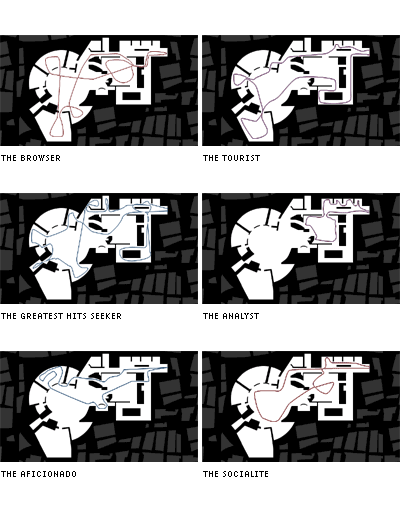
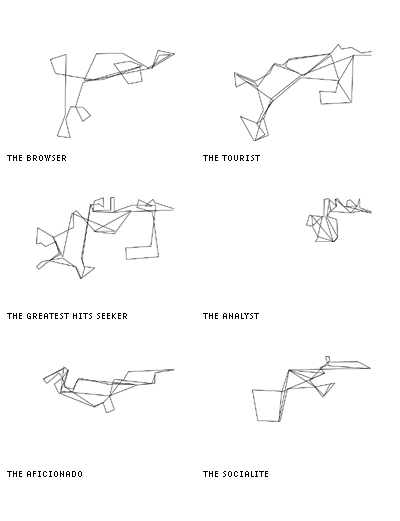
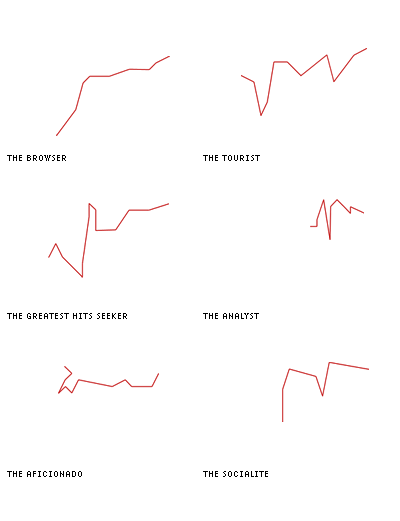
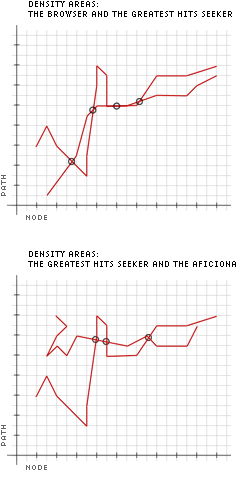
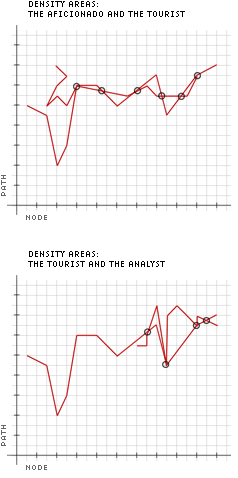
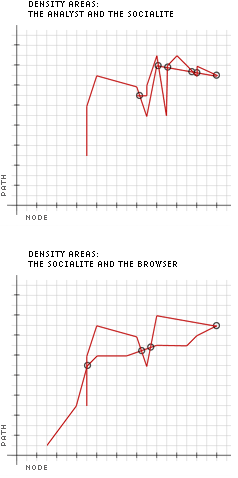
HOW IT WORKS The proposed technocratic museum is a navigatable digital space for social interaction and information trading. The network is a hybrid of a peer-to-peer application, which allows file sharing, and a social networking tool, which permits algorithmically determined connections and associations between users. The network can broaden the range of information realization beyond typical museum technologies like websites and kiosks, and even beyond in the museum itself.
In this network space, there is no central architecture—the system's main attributes are its perpetual movement, lack of physical infrastructure, and the ultimate control by its participants. Unlike the structure of the Internet which depends on the mega-processing power of Internet Service Providers, each user in this network pools computer processing power, storage space, and content. The result is a decentralized and novel cooperative environment. Cultural theorist William Mitchell describes this shift as one from a fixed point of presence to a "field of presence."[12] This virtual (re)location—emblematized in the technocratic museum—loosens temporal and spatial relationships; the physicality of the architecture evaporates as the museum's reach expands. In the museum's field of presence, access is geographically independent, museum inventories are fully viewable, and associations are made across non-traditional curatorial divisions and atypical objects. The soft-structure of this space reterritorializes the traditional museum by offering alternative conceptions of virtual objects through diverse groupings of narratives with no single author.
The network is visualized as a dynamic map that
illustrates the complex social relationships at play in the acquisition of
cultural knowledge. This manifestation is built on the principle that knowledge
does not preexist the object but is made through collaboration and exchange.
The interface is represented as a two-dimensional spatial topography (both as a
growth map and a flat visual sweep of topics) rather than in a typical,
hierarchical structure. In addition to being able to transparently represent
patterns and traffic in the system, the spatial network exposes its own
possessing behavior and makes visible the network at large visible
(conventional interfaces obscure these two factors). The spatial organization
enables an adaptive information architecture where user behavior creates the
structure. Navigation is not ordered through a pre-set taxonomy, but is based
on a constellation of queries, associative connections, and asides. This
information space provides an alternative mode of distributing data and that
engenders new forms of social and cultural interaction.[13]
A user launches the application and is made visible as an icon on the network map by initiating a search; sharing annotated data from their own location; or receiving a content query from another user. (Contrasting with the deliberate wayfinding found in the physical museum environment, the network visualizes other user's queries throughout the system, demonstrating the social and spontaneous quality of the network.) These images illustrate two views of the network: as an organic real-time map of interaction, and as tree application with a visual hierarchy of popular topics. Users can toggle between both.
Network content takes form as viewable and downloadable text, audio, video, and animation. This content may be created by the user, or acquired and transmitted by scanning digitally annotated museum objects through the infrared receivers on a cell phone, PDA, or laptop. Users are encouraged to be actively engaged with the system by contributing sharing files, linking to nodes, and posing queries.
The interface vantage point is from the user's perspective, rather than from an artificial objective distance.[14] All connections on the network map are made actively through the user's behavior (although there is a serendipitous quality because the user links to a node which may have other links and nodes attached). Linked nodes increase in size based on the number of user files shared throughout the system. The degree of transparency of the node indicates its geographical distance from the viewer (counted by the number of hubs information travels through). The ring around a node thickens according to the level of similar and/or compatible interests shared between the user and the node. The relative darkness of the color band indicates whether the node is considered compatible based on the expressed preferences in the user's profile, or the network's prediction as formulated through collaborative filtering. Clusters are indicated with spokes that project from the directly linked node. The viewer can click on an ancillary node in the cluster to enlarge it, thereby making that node "active" and its files visible. Clicking on the ancillary node also makes that node's cluster visible.
This system does not contain a formal curatorial filter. In its place, participants use a reputation system, which utilizes the notion of the exchange value of social capital, trust, goodwill, and identity to manage content and user behavior. The peer network is self-regulating through cooperation and reciprocation. Network pollution is discouraged by a layer of reputation system functionality which enables participants to rank other users based on the quality of their content (high, medium, low), type of content (scholarly, popular, scientific, historical), and reliability of exchange (slow connection, undependable connection, etc.). In addition, the system allows particular nodes to be made invisible if the viewer chooses. (In collaborative networks, users usually block offensive or uninteresting content in this way.) The reputation system provides a functional mechanism to control "noise" on the network. Although this noise is greater than that found in the filtered traditional museum environment, the benefit of this open system is that is enjoins a greater number and variety of perspectives, and puts the user in the curatorial position.
The inclusion of a social networking protocol, which
allows users to describe their preferences and interests, serves three
functions. First, it enables users to identify participants on the system with
similar interests. Second, through a collaborative filtering mechanism based on
the archetype users defined earlier (and indicated in the node banding), users
are identified with associated—but perhaps not instantly recognizable—interests
(as indicated in the color of the node band). Finally, the commitment
associated with creating and maintaining the profile is intended to increase
participation in the system, and maximize the quality of exchange.[15]
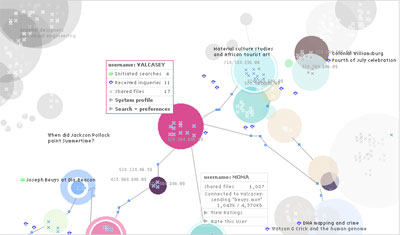
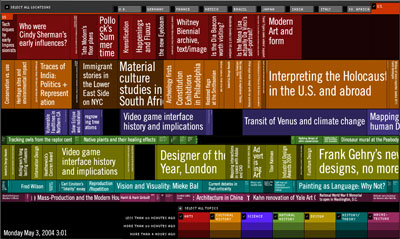
WHY IT WORKS While it may seem inconceivable to replace objects with non-material data, analysis of the structure of the museum experience through the circuit of language and visuality indicates that the authentic museum object has already been de-realized. Cultural theorist Arjun Appadurai's critique of the social life of things helps elaborate this condition. Appadurai posits that value is positioned in relation to the judgment of the object by the subject, and therefore shifts from being conceived as essential, to being potential.[16] Value is realized through exchange within a social, political, and economic confluence, and the value of the object is fluid.
However, cultural institutions like
museums interrupt this process. When art and artifacts are acquired by museums,
(in most cases) they are permanently removed from circulation, and value is
fixed through status within the museum collection. The value of a museum object
is therefore determined through a less visible and tangible system than seen in
the marketplace. While both are influenced by commerce (although art is often
inaccurately perceived of as separate from economics), in the museum, exchange
value is governed by an alternative economy based on social credit and symbolic
value. The aura of art becomes the legal tender of culture, and visits to the
museum provide returns in the form of expected cultural benefit, membership to
an exclusive group, and the satisfaction of quasi-scholastic disposition.[17]
These ends are negotiated between visitors and the museum, and enabled through
curatorial intervention. Social anthropologist Pierre Bourdieu analyzes this
(socially necessary) role of cultural intermediaries in facilitating the
exchange: "works of art exist as symbolic objects only if they are known and
recognized, that is, socially instituted as works of art and received by
spectators capable of knowing and recognizing them as such."[18]
By consecrating objects through intermediaries such as curators, docents, and
exhibition designers, museums symbolically produce value through their
visitors. By creating their audience's expectations and fulfilling them,
museums constitute their own audiences through this exchange.[19]
Museum ideologies (usually formed around themes of national identity, social progress, and bourgeois taste) are prepared in advance of object exhibition through design anchors which prime particular responses. Until recently museum processes of display have been invisible to the viewer—the museums' cultural authority has resided in the transparency of their object-making.[20] However, pressure from popular culture is already changing the museum. To abate the advancing fatigue with the authentic object, contemporary museums have used their intimate knowledge of display to appeal to experience-oriented audiences.[21] The focus on civic and social aspects of the museum experience (often manifested through theming and theatrical methods used to drive attendance) has begun to reprioritize the museum's object. The museum practice of using exhibition design to interpret object meaning has given way to the design of exhibition, where the ensemble of display has superceded the material object. As a result, the increasingly sophisticated methods of design and representation used to direct viewer attention have actually made the negotiated status of museum art and artifacts more visible.
The technocratic museum extends this trajectory by further visualizing the process of meaning-making in the museum. By focusing on the construction of the museum object, the visualization of that construction becomes the object. The authentic object is "broken" in the process—however, its strength, and thus the strength of the technocratic museum, is that it cannot be broken any further. The authentic object has always anticipated its own destruction, because its very authority was held in the invisibility of display that created its value. Even as museums have sought to balance their methods while maintaining their cultural status, their design techniques have become more prominent.[22] As audiences seek more entertainment, the contemporary museum object can no longer hold the narrative. The demand exceeds the object, and the process becomes visible. This situation makes the technocratic museum the natural next-step in museum development; through hyperrealizing the construction of the authentic object (through information visualization) it creates a new museum object.
CONCLUSION The museum is not culturally defunct. Society will always need places to mark time, to contain aesthetic icons, to enable memory to be experienced by proxy. However, the increased sophistication of display has exposed the circuit of value-making in the museum. The myth of object autonomy and authenticity upon which the museum's cultural authority is founded begins to dissipate as museum visitors recognize the degree to which design and display embeds museal objects with value. Made evident through the popular orientation of museum practices, focus is increasingly directed not to the object but to the information around the work. Digital technologies amplify this effect. In light of this condition, museum technologies offer an opportunity to generate new ways to conceive of contemporary art and artifacts by activating the potential of networks and by bringing together individual and group knowledge in real-time.[23]
The proposed theoretical proposition offers one image of how the technocratic museum could be configured. Like architect Friederick Kiesler's utopian vision of the Endless House—this technology envisions the network's ability to generate a culturally oriented datascape with "no start or no end."[24] In terms of maintaining this dematerialized museum without the traditional notion of object aura, Benjamin writes: "in permitting the reproduction to meet the beholder or listener in his own particular situation, [mechanical reproduction] reactivates the object reproduced." Benjamin believed that the "post-auratic" object could actually create a new relationship between the viewer, the object, and the environment.[25] Change is well underway in the museum, and while technology cannot automatically reorder power relations in a hegemonic system, it can provide new ways to reconfigure dominant systems through new interactive potential.
NOTES
[1] Appadurai writes, "value [is] accelerated or enhanced by placing objects and things in unlikely contexts." (Appadurai, 1986: 28). Display reconfigures an object's environment—calling out of the artificial setting of the object (i.e., the museum vitrine) inversely creates its aura.
[2] Stated in research interview (10/17/03) with the Deborah Howes, Museum Educator at the Metropolitan Museum, based on her team�s observations made in the Educational Programming Department. The MET is a "survey" museum—meaning it deals with art, artifacts, history, natural history—and receives approximately 4.5 million visitors a year.
[3] Art historian Tim Barringer anecdotally describes the power of the museum to "create art" by referencing a recent addition to the Yale Center for British Art. An "out-of-fashion, 17th century, counter-reformation, soft-porn nude" found in a dealer's back room by "an astute curator" was purchased "as cheap as chips" and transformed to an esteemed work of art through its placement in the Mellon collection. (Guided tour of the BAC collection, 04/07/04)
[4] Frankfurt School theorist Walter Benjamin wrote that technologies enabling reproduction "detach the reproduced object from the domain of tradition," thus separating it from the context of temporal and spatial particularities. Walter Benjamin, "Art in the Age of Mechanical Reproduction" Illuminations (Berlin: Schocken Books, 1985).
[5] The decreased cost of glass revolutionized these displays by articulating specialized spaces—museum vitrines, arcade infrastructure, department store windows, display cases. The effect separated objects from everyday usage, and helped generate their aura.
[6] Precedents that indicate this movement include: the museums online initiative (.museum Internet extension); recent UNESCO initiatives; The Crystal Web museum project; the normalization of museum guide experience; the Guggenheim franchise model; AAM museum certification. These represent a selection of observable trends in systematizing the museum experience through technology.
[7] Media theorist Sherry Turkle writes: "Many of the institutions that used to bring us together—a main street, a union hall, a town meeting—no longer work as before. Most people spend most of their day alone at a screen of a television or a computer. Meanwhile, social beings that we are, we are trying (as Marshall McLuhan said) to retribalize. And the computer (and new media) is playing a central role." Sherry Turkle, Life on the Screen (New York: Simon & Schuster, 1995). McLuhan predicted that this social retribalization would occur as a "single landscape," possessed of its own internal logic. Marshal McLuhan, Understanding Media (New York : McGraw-Hill 1964). Cultural theorist Lev Manovich extends McLuhan's metaphor by offering that the logic of the computer and the database provide the new paradigm for culture at large. Lev Manovich, The Language of New Media (Cambridge: MIT Press, 2001).
[8] Social theorist Manuel Castells writes: "as a historical trend, dominant functions and processes in the information age are increasingly organized around networks. Networks constitute the new social morphology of our societies, and the diffusion of networking logic substantially modifies the operation and outcomes in processes of production, experience, power and culture." Manuel Castells, The Rise of the Network Society (Oxford: Blackwell Publishers, 1996) 469. We are on the cusp of a social revolution facilitated by networked technology, in particular wireless technology. Past models of information generation and receipt are shifting due to the emergence of new ways for people to communicate with each other. Through mobile technology, peer-to-peer networks, collaborative filtering, and reputation systems, users create value by participating in collective knowledge pools and sharing information that benefit the common good. Media theorist Howard Rheingold writes, "The 'killer apps' of tomorrow's mobile infocom industry won't be hardware devices or software programs but social practices." Howard Rheingold, Smart Mobs (Cambridge: Perseus Publishing, 2002). Not only is the medium the message, but now the medium is social practice and the message is cultural change. Through technology-saturated culture, information has reached new levels of novelty (in media types) and imbrications into popular culture. Detached from the object, information can activated to unlock the latent value of user (museum visitor) input. This social phenomenon, facilitated by pervasive computing (which allows mobility), location-autonomy (which permits placelessness), and multimedia (which promotes understanding through a variety of modes), enables people to act in concert across time and geographic distance.
[9] Ann Grogg, Museums Count: A Report (American Association of Museums: 1994); Ervin Goffman, Interaction Ritual(New York: Pantheon Books, 1982); Joseph Pine and James Gilmore, The Experience Economy (Boston: Harvard Business School Press, 1999).
[10] Herbert Bayer, "Fundamentals of Exhibition Design," P.M. (Production Manager) 6, no. 2 (December 1939–January 1940) 19–21; Nikolaus Pevsner, History of Building Types (Princeton, N.J. : Princeton University Press, 1976); Steven Keller, Cultural Property Standards Manual (expected publication Fall 2004); Suzanne Stephens, Building the new museum (Princeton: Princeton Architectural Press, 1986); Rene d�Harnoncourt, "Modern Art in Your Life," Interiors 109, no. 4 (November 1949), 97.
[11] Specifically, the Baltimore Aquarium, Dewitt Wallace Decorative Arts Museum, the Experience Music Project, Guggenheim New York, Guggenheim Las Vegas, the MET, the Peabody Museum, the San Francisco Exploratorium, SF MOMA, the Walters Art Museum, the Whitney, Yale Art Gallery, Yale Center for British Art.
[12] William Mitchell, Me++: The cyborg self and the networked city (Cambridge: MIT Press, 2003).
[13] The inspiration for the model of this system came from the work of Schoenerwissen / Office for Computational Design (Pascual, Anne; Hauer, Marcus; Concept in Cooperation with Reck, Hans Ulrich), "txtkit: Visual Text Mining Tool", Berlin, v1.0.0 released under GPL in January 2004, and "Minitasking", Berlin, v1.0.0 released under GPL in April 2002, See: http://www.txtkit.sw.ofcd.com; and Martin Dodge's excellent article: Martin Dodge, "Mapping Peer-to-Peer Networks" http://www.cybergeography.org/maps/maps26.html (04/17/04). The treemap graphic is a modification of Marcos Weskamp's Newsmap. (http://www.marumushi.com/apps/newsmap/newsmap.cfm: Newsmap is an application that visually reflects the constantly changing landscape of the Google News news aggregator.) I selected to use pre-existing visual logic to show that this "future" is not too distant. Other influences in priming these ideas: Rheingold, 2002; Bill Cheswick and Hal Burch, The Internet Mapping Project http://research.lumeta.com/ches/map/; Andy Oram (ed.) Peer-to-Peer: Harnessing the Power of Disruptive Technologies (Sebastopol: O'Reilly, 2001); Martin Dodge and Rob Kitchin, Mapping cyberspace (London: Routledge, 2001). An interesting discovery about subjectivity in museum interfaces occurred with the Tate Modern Pilot program by Antenna Audio. On the new museum guide, there were several multimedia features including a map of gallery plan which was tied into a network through IR. In this feature, the user was mapped on the screen as a moving dot (identified by their PDA MACID). In user feedback sessions, almost unilaterally, users described the disquieting effect of seeing themselves represented in this way. The dot brought the users back to the present tense of the museum. Although the design was unintentional—mapping the users was actually a way to track the devices—it presented an interesting insight into the tension between visitor objectivity and subjectivity.
[15] A 2000 study of the P2P network Gnutella indicated that 70% of Gnutella users share no files, and "nearly 50% of all responses are returned by the top 1% of sharing hosts." Eytan Adar and Bernardo A. Huberman, "Free Riding on Gnutella" First Monday (Vol. 5, No. 10, October 2000).
[16] As exchange creates value, those conditions become political—that is, they are influenced by the situational effect of each exchange. As objects move through different environments—their value constantly in flux—they are like people with social lives, adjusting and adapting to each situation. Appadurai writes that the organization of object status depends upon "criteria (symbolic, classificatory, and moral) that define the exchangeability of a thing in any particular social and historical context." To Appadurai, an object's candidacy in the realm of exchange is determined by desire and demand, and reciprocal sacrifice and power. Arjun Appadurai, The Social Life of Things (Cambridge: Cambridge University Press, 1986) 14.
[17] Bourdieu's study of why people engage in culture is particularly illuminating on this point. Pierre Bourdieu, Distinction (Cambridge: Harvard University Press, 1987).
[18] Pierre Bourdieu. The Field of Cultural Production (Cambridge, England: Polity Press, 1993) 37.
[19] Cultural theorist Stuart Hall's critique of television culture is adapted here—like television, the museum is an instrument or apparatus that constitutes its audience through representation. One might add that while television produces programs, museums produce serial authenticity. Stuart Hall, "Which public, whose service?", in W Stevenson (ed.), All our Futures, the Changing Role and Purpose of the BBC (London: British Film Institute, 1993) 32.
[20] Of the production of artistic and literary works, Bourdieu writes, "these practices can only work by pretending not to be doing what they are doing." Bourdieu, 1993: 74
[21] One byproduct of the increasing populist appeal of the museum is the shifting social credit assigned to museum-going. Since value in the museum—as received through the aggregated experience of architecture, design, and interpretation—is based on social credit, the rising attention given to (less discriminating and less educated) tourist culture diminishes this value, blurring the formerly productive distinction between high and low culture. The marriage of museum styling and theming is especially visible in the "living history" museum, which constitutes the largest growth segment in US and European museums since the 1980s. (John Urry, The Tourist Gaze. London: Sage, 2002). Living museums render meaning by dramatizing events and by recasting objects by privileging their use-value (relationship to human activity) over cult-value (derived from their placement in the museum). Also, unlike their traditional museum predecessors, sequences in living museums are not comprised of linear narratives, but instead revolve around inhabitable worlds. The villages, farms, and revived industrial sites of the living museum are animated dioramas that celebrate the banality of everyday life in an historical era.
Critics
disparage the popular disposition of these heritage sites, regarding them as
facile and vulgar. This particular type of museum is
often critically likened to reality television programming. The common
non-remarkable display of churning butter and milling wood in these heritage
sites is considered a sort of reality TV-like mad cow disease where the
ordinary is fed to the ordinary—a cannibalizing of the audience's
audienceness. Salman Rushdie's scathing 2001 review of reality television could
easily have been made of the living museum, "once so idealistically thought of
as our window on the world, has become a dime-store mirror instead, Who needs
images of the world's rich otherness, when you can watch these half-familiar
avatars of yourself—that half-attractive half-persons—enacting
ordinary life under weird conditions? Who needs talent, when the unashamed
self-display of the talentless is constantly on offer?" Salman Rushdie,
"Reality TV: a dearth of talent and the death of morality," The Guardian, 9 Jun 2001.
Cultural theorist Patrick Brantlinger
traces a class crisis similar to that of the contemporary museum. In the early
19th century, the literary industry was criticized for inciting a
"rhetoric of toxicity" for appealing to the masses, and disregarding the
traditionally held belief that literary works were a product of an autonomous
artist's creativity, and meant for a narrow, learned audience. By promoting
books for public tastes and popular consumption, writers and publishers were
"likely to do moral damage to readers and, indeed, to national culture."
Brantlinger's description of the comment on mass readership's "uncritical
demand for easy vicarious indulgence" is easily applied to current tenor of
museum critique which denounces its commercialization. Unfortunately, as the
new museum is decried for its appeal to popular tastes through exhibition
design techniques, critics often focus on the cosmetic issues and miss the
potential to open up the museum to critical possibilities. Patrick Brantlinger,
The Reading Lesson: The Threat of Mass Literacy in Nineteenth-Century
British Fiction
(Bloomington: Indiana University Press, 1998) 1, 25. Brantlinger's work is used
to analyze the effect of digital media and online sales in readership in
Christine Nadir, "Amazon.com: The Production of the Consumer
of Cultural Products," <http://www.restlessculture.net/hvc/article.html>,
(4/14/04).
[22] The recent museum
mania in architecture has come dangerously close to "admitting" the power of
spatial drama (and surfacing) in creating the museum's importance.
[23] The open, bottom-up
network also contrasts with current museum technologies which often simply reproduce
analog curatorial intervention under the guise of offering choice.
[24] Kielser's
description of the Endless House: Friedrich Kiesler-Zentrum Wien, Friedrich
Kiesler: Art of This Century (New York: Distributed Art Publications, 2002).
[25] Huyssen provides a
summary of Benjamin and Adorno's (opposing) views of the liberating powers of
technology: Teresa de Lauretis et al (eds.), The Technological imagination:
Theories and Fictions
(Madison: Coda Press, 1980).